Project Management Report: Knowledge Areas and Case Studies
VerifiedAdded on 2022/08/27
|48
|13336
|34
Report
AI Summary
This report provides an in-depth analysis of project management, focusing on three key knowledge areas: scope, risk, and cost management. The study examines these areas through the lens of three case studies: a lecture capture upgrade project, the Sydney Opera House construction, and the severe exploitation of foreign workers in Australia. The report delves into the literature review of these areas, discussing the processes involved and the importance of efficient project management. The methodology includes analyzing the problems, research methodologies, and findings of each case study. The results and findings section compares scope, risk, and cost management across the selected case studies. The report concludes with recommendations and limitations, aiming to provide a comprehensive understanding of project management practices and their application in real-world scenarios. The report emphasizes the importance of defining project work and using existing project management knowledge to improve current and future projects. This document is available on Desklib, a platform providing AI-based study tools for students.

Running head: PROJECT MANAGEMENT
Assessment 4: Project Management
Student Name:
Student Number:
Assessment 4: Project Management
Student Name:
Student Number:
Paraphrase This Document
Need a fresh take? Get an instant paraphrase of this document with our AI Paraphraser

1PROJECT MANAGEMENT
Abstract
The report is focused on analyzing three of the project management knowledge
areas such as scope, risk and cost management. In this study, three of the case
studies are discussed and analyzed such as lecture capture upgrade project, Sydney
Opera House and Severe exploitation of foreign workers in Australia. Selected
project knowledge areas are selected to achieve an efficient project management.
The areas are included processes which needed to perform in its discipline.
Literature study is conducted based on three knowledge areas for better
management of the construction project work. There is representation of completed
set of the project management concepts and activities that make a professional
project field. The knowledge areas discussed how the areas are worked in process
groups for defining project processes. It reuses existing project management
knowledge and creates new knowledge. Those are captured to make improvement
in current project and future scheme. The project developments are managed and
directed to lead the construction development work. In this paper, in results and
findings section, a comparison table is provided to compare scope, risk and cost
management based on selected three case studies. Defined project work is helpful
to approve project changes for achieving the project objectives.
Keywords: Scope management, risk management, cost management, project
management, knowledge areas
Abstract
The report is focused on analyzing three of the project management knowledge
areas such as scope, risk and cost management. In this study, three of the case
studies are discussed and analyzed such as lecture capture upgrade project, Sydney
Opera House and Severe exploitation of foreign workers in Australia. Selected
project knowledge areas are selected to achieve an efficient project management.
The areas are included processes which needed to perform in its discipline.
Literature study is conducted based on three knowledge areas for better
management of the construction project work. There is representation of completed
set of the project management concepts and activities that make a professional
project field. The knowledge areas discussed how the areas are worked in process
groups for defining project processes. It reuses existing project management
knowledge and creates new knowledge. Those are captured to make improvement
in current project and future scheme. The project developments are managed and
directed to lead the construction development work. In this paper, in results and
findings section, a comparison table is provided to compare scope, risk and cost
management based on selected three case studies. Defined project work is helpful
to approve project changes for achieving the project objectives.
Keywords: Scope management, risk management, cost management, project
management, knowledge areas
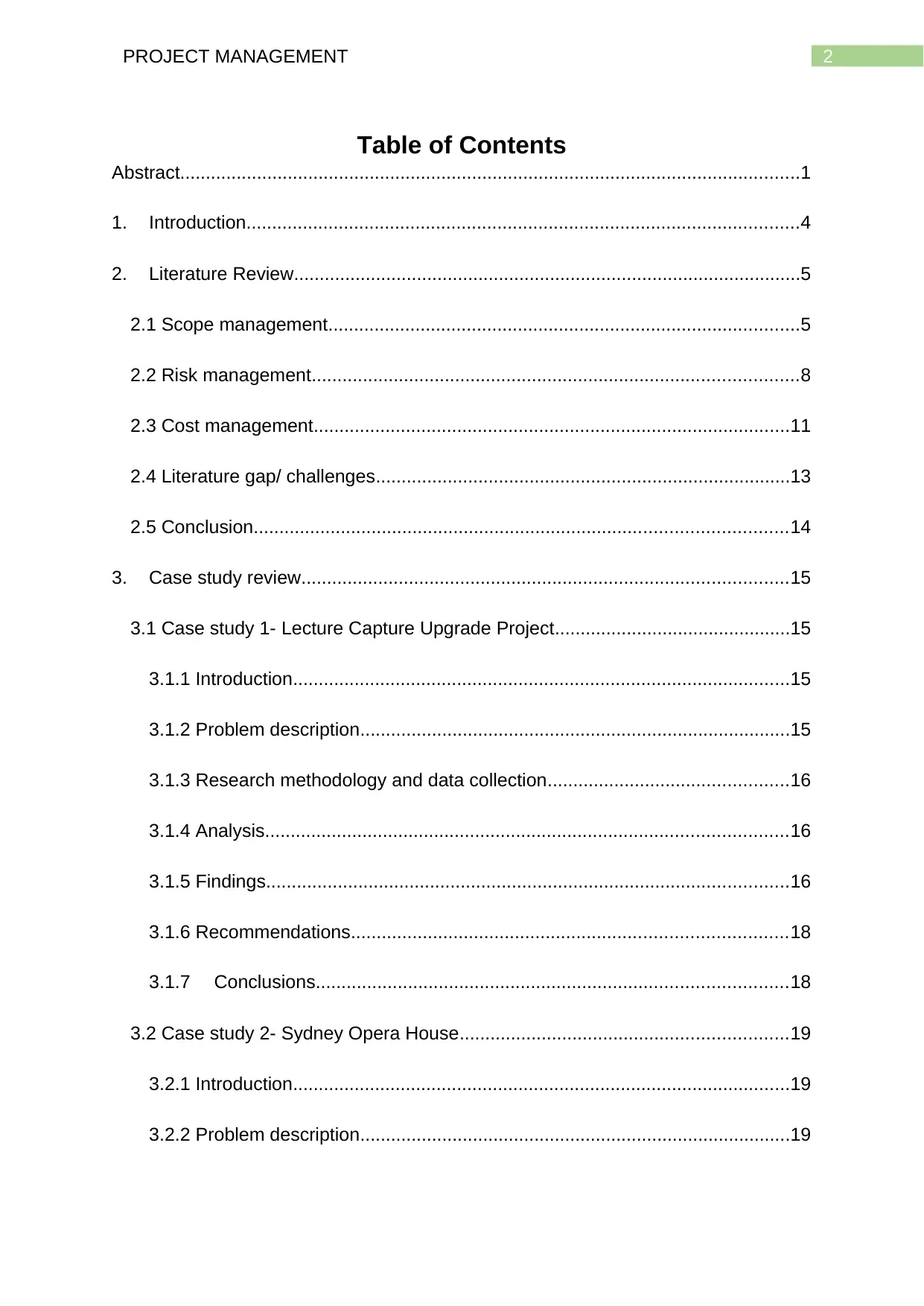
2PROJECT MANAGEMENT
Table of Contents
Abstract.........................................................................................................................1
1. Introduction............................................................................................................4
2. Literature Review...................................................................................................5
2.1 Scope management............................................................................................5
2.2 Risk management...............................................................................................8
2.3 Cost management.............................................................................................11
2.4 Literature gap/ challenges.................................................................................13
2.5 Conclusion........................................................................................................14
3. Case study review...............................................................................................15
3.1 Case study 1- Lecture Capture Upgrade Project..............................................15
3.1.1 Introduction.................................................................................................15
3.1.2 Problem description....................................................................................15
3.1.3 Research methodology and data collection...............................................16
3.1.4 Analysis......................................................................................................16
3.1.5 Findings......................................................................................................16
3.1.6 Recommendations.....................................................................................18
3.1.7 Conclusions............................................................................................18
3.2 Case study 2- Sydney Opera House................................................................19
3.2.1 Introduction.................................................................................................19
3.2.2 Problem description....................................................................................19
Table of Contents
Abstract.........................................................................................................................1
1. Introduction............................................................................................................4
2. Literature Review...................................................................................................5
2.1 Scope management............................................................................................5
2.2 Risk management...............................................................................................8
2.3 Cost management.............................................................................................11
2.4 Literature gap/ challenges.................................................................................13
2.5 Conclusion........................................................................................................14
3. Case study review...............................................................................................15
3.1 Case study 1- Lecture Capture Upgrade Project..............................................15
3.1.1 Introduction.................................................................................................15
3.1.2 Problem description....................................................................................15
3.1.3 Research methodology and data collection...............................................16
3.1.4 Analysis......................................................................................................16
3.1.5 Findings......................................................................................................16
3.1.6 Recommendations.....................................................................................18
3.1.7 Conclusions............................................................................................18
3.2 Case study 2- Sydney Opera House................................................................19
3.2.1 Introduction.................................................................................................19
3.2.2 Problem description....................................................................................19
⊘ This is a preview!⊘
Do you want full access?
Subscribe today to unlock all pages.

Trusted by 1+ million students worldwide

3PROJECT MANAGEMENT
3.3.3 Research methodology and data collection...............................................19
3.3.4 Analysis......................................................................................................20
3.3.5 Findings......................................................................................................20
3.3.6 Recommendations..................................................................................21
3.3.7 Conclusions............................................................................................22
3.3 Case study 3- Severe Exploitation of Foreign Workers in Australia.................22
3.3.1 Introduction.................................................................................................22
3.3.2 Problem description....................................................................................23
3.3.3 Research methodology and data collection...............................................23
3.3.4 Analysis......................................................................................................24
3.3.5 Findings......................................................................................................24
3.3.6 Recommendations.....................................................................................25
3.3.7 Conclusions................................................................................................25
4. Results and findings............................................................................................26
5. Conclusions and recommendations....................................................................38
5.1 Limitations.........................................................................................................40
References.................................................................................................................41
3.3.3 Research methodology and data collection...............................................19
3.3.4 Analysis......................................................................................................20
3.3.5 Findings......................................................................................................20
3.3.6 Recommendations..................................................................................21
3.3.7 Conclusions............................................................................................22
3.3 Case study 3- Severe Exploitation of Foreign Workers in Australia.................22
3.3.1 Introduction.................................................................................................22
3.3.2 Problem description....................................................................................23
3.3.3 Research methodology and data collection...............................................23
3.3.4 Analysis......................................................................................................24
3.3.5 Findings......................................................................................................24
3.3.6 Recommendations.....................................................................................25
3.3.7 Conclusions................................................................................................25
4. Results and findings............................................................................................26
5. Conclusions and recommendations....................................................................38
5.1 Limitations.........................................................................................................40
References.................................................................................................................41
Paraphrase This Document
Need a fresh take? Get an instant paraphrase of this document with our AI Paraphraser
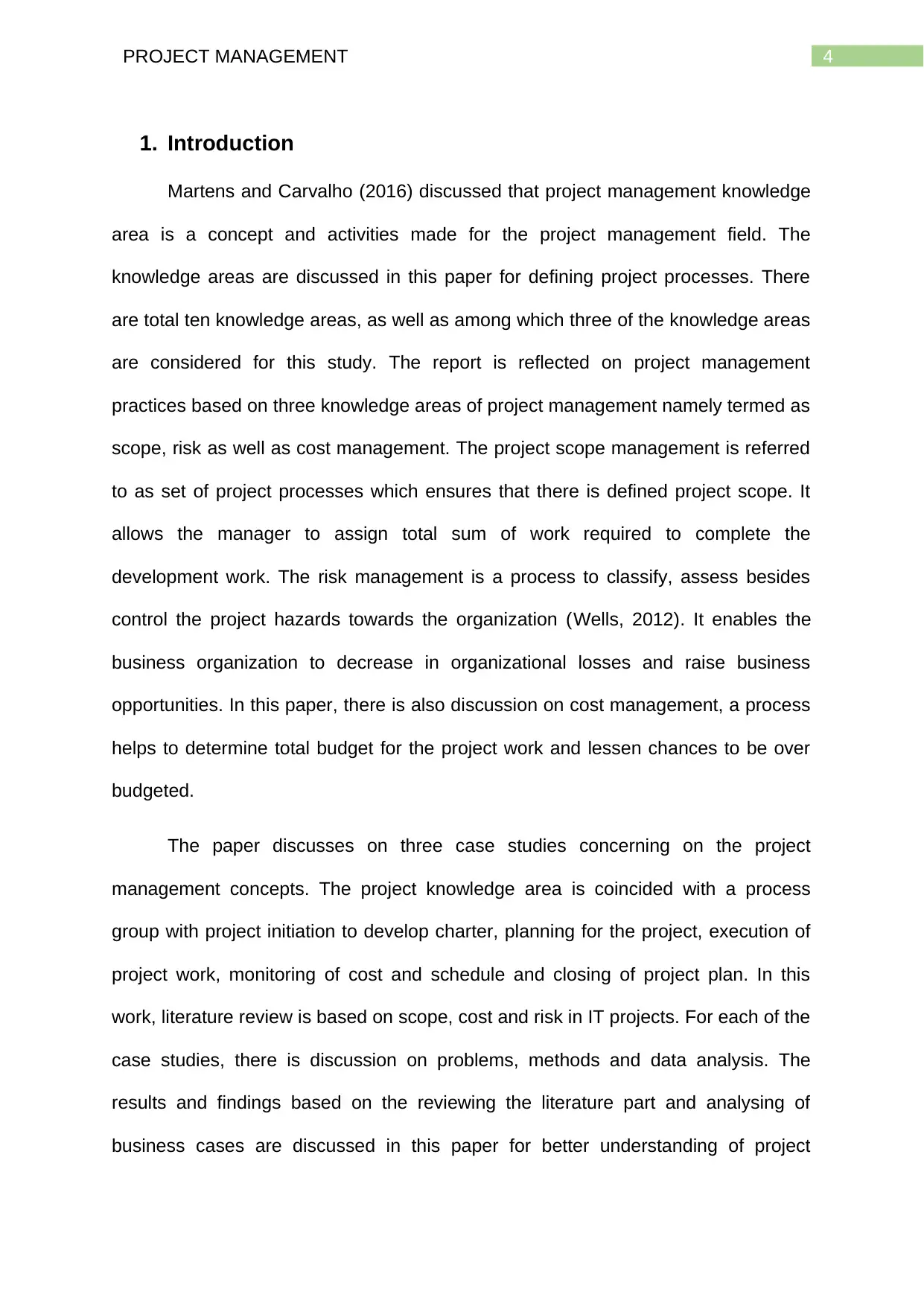
4PROJECT MANAGEMENT
1. Introduction
Martens and Carvalho (2016) discussed that project management knowledge
area is a concept and activities made for the project management field. The
knowledge areas are discussed in this paper for defining project processes. There
are total ten knowledge areas, as well as among which three of the knowledge areas
are considered for this study. The report is reflected on project management
practices based on three knowledge areas of project management namely termed as
scope, risk as well as cost management. The project scope management is referred
to as set of project processes which ensures that there is defined project scope. It
allows the manager to assign total sum of work required to complete the
development work. The risk management is a process to classify, assess besides
control the project hazards towards the organization (Wells, 2012). It enables the
business organization to decrease in organizational losses and raise business
opportunities. In this paper, there is also discussion on cost management, a process
helps to determine total budget for the project work and lessen chances to be over
budgeted.
The paper discusses on three case studies concerning on the project
management concepts. The project knowledge area is coincided with a process
group with project initiation to develop charter, planning for the project, execution of
project work, monitoring of cost and schedule and closing of project plan. In this
work, literature review is based on scope, cost and risk in IT projects. For each of the
case studies, there is discussion on problems, methods and data analysis. The
results and findings based on the reviewing the literature part and analysing of
business cases are discussed in this paper for better understanding of project
1. Introduction
Martens and Carvalho (2016) discussed that project management knowledge
area is a concept and activities made for the project management field. The
knowledge areas are discussed in this paper for defining project processes. There
are total ten knowledge areas, as well as among which three of the knowledge areas
are considered for this study. The report is reflected on project management
practices based on three knowledge areas of project management namely termed as
scope, risk as well as cost management. The project scope management is referred
to as set of project processes which ensures that there is defined project scope. It
allows the manager to assign total sum of work required to complete the
development work. The risk management is a process to classify, assess besides
control the project hazards towards the organization (Wells, 2012). It enables the
business organization to decrease in organizational losses and raise business
opportunities. In this paper, there is also discussion on cost management, a process
helps to determine total budget for the project work and lessen chances to be over
budgeted.
The paper discusses on three case studies concerning on the project
management concepts. The project knowledge area is coincided with a process
group with project initiation to develop charter, planning for the project, execution of
project work, monitoring of cost and schedule and closing of project plan. In this
work, literature review is based on scope, cost and risk in IT projects. For each of the
case studies, there is discussion on problems, methods and data analysis. The
results and findings based on the reviewing the literature part and analysing of
business cases are discussed in this paper for better understanding of project
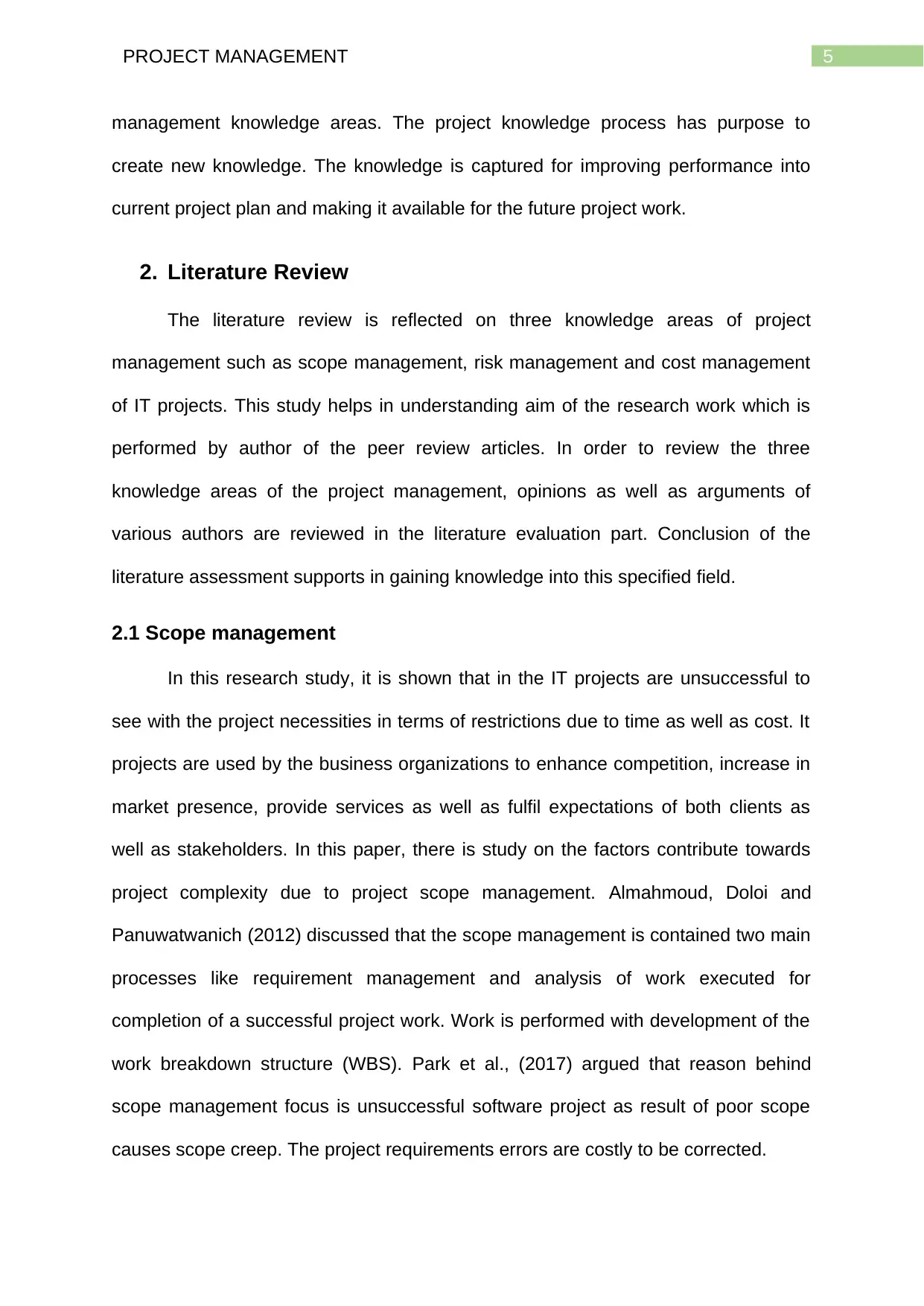
5PROJECT MANAGEMENT
management knowledge areas. The project knowledge process has purpose to
create new knowledge. The knowledge is captured for improving performance into
current project plan and making it available for the future project work.
2. Literature Review
The literature review is reflected on three knowledge areas of project
management such as scope management, risk management and cost management
of IT projects. This study helps in understanding aim of the research work which is
performed by author of the peer review articles. In order to review the three
knowledge areas of the project management, opinions as well as arguments of
various authors are reviewed in the literature evaluation part. Conclusion of the
literature assessment supports in gaining knowledge into this specified field.
2.1 Scope management
In this research study, it is shown that in the IT projects are unsuccessful to
see with the project necessities in terms of restrictions due to time as well as cost. It
projects are used by the business organizations to enhance competition, increase in
market presence, provide services as well as fulfil expectations of both clients as
well as stakeholders. In this paper, there is study on the factors contribute towards
project complexity due to project scope management. Almahmoud, Doloi and
Panuwatwanich (2012) discussed that the scope management is contained two main
processes like requirement management and analysis of work executed for
completion of a successful project work. Work is performed with development of the
work breakdown structure (WBS). Park et al., (2017) argued that reason behind
scope management focus is unsuccessful software project as result of poor scope
causes scope creep. The project requirements errors are costly to be corrected.
management knowledge areas. The project knowledge process has purpose to
create new knowledge. The knowledge is captured for improving performance into
current project plan and making it available for the future project work.
2. Literature Review
The literature review is reflected on three knowledge areas of project
management such as scope management, risk management and cost management
of IT projects. This study helps in understanding aim of the research work which is
performed by author of the peer review articles. In order to review the three
knowledge areas of the project management, opinions as well as arguments of
various authors are reviewed in the literature evaluation part. Conclusion of the
literature assessment supports in gaining knowledge into this specified field.
2.1 Scope management
In this research study, it is shown that in the IT projects are unsuccessful to
see with the project necessities in terms of restrictions due to time as well as cost. It
projects are used by the business organizations to enhance competition, increase in
market presence, provide services as well as fulfil expectations of both clients as
well as stakeholders. In this paper, there is study on the factors contribute towards
project complexity due to project scope management. Almahmoud, Doloi and
Panuwatwanich (2012) discussed that the scope management is contained two main
processes like requirement management and analysis of work executed for
completion of a successful project work. Work is performed with development of the
work breakdown structure (WBS). Park et al., (2017) argued that reason behind
scope management focus is unsuccessful software project as result of poor scope
causes scope creep. The project requirements errors are costly to be corrected.
⊘ This is a preview!⊘
Do you want full access?
Subscribe today to unlock all pages.

Trusted by 1+ million students worldwide

6PROJECT MANAGEMENT
Corvello, Javernick-Will and Ratta (2017) mentioned that the scope
management is termed as activity where expectations of stakeholders as well as
project requirements are gathered to define the project work. Improper scope can
lead to project delays, increase in project cost and sudden project changes through
the project execution phase. Sanghera (2019) illustrated that a process to organize
and document project requirements for complex system is termed as requirement
management. Considering the IT projects as hardware as well as software evolved,
software developers are started to deal in increasing complexity of the IT systems.
Complexity is related to It product as well as IT development process. From the
viewpoint of project management, managing project scope is required to overcome
with scope creep. In each IT projects, scope is required to be met and updated on
time before performing the project work. Fuller et al., (2017) stated that the IT
projects are differed as it is complicated along with technology dependent. The IT
projects are complex as it is dealing with the technical matters but the structural
factors are outside the control of development team.
Before starting the IT project work, the business is required to understand
stakeholder’s expectations that are involved and got buy-in from each of the project
stakeholders. Christoph Albrecht and Spang (2014) discussed that the scope of IT
project is defined which includes responsibilities as well as roles of the development
team members. The project plan as well as goals are developed, and created as the
project criteria to complete a positive project. In order to get an effective project plan,
it is required to know about roles of the development team members, who are
responsible for which development activities. It makes an easier to create project
accountability. Cicmil et al., (2019) mentioned that stakeholder’s expectations are set
and each one should know about the project deliverables. The purpose of this
Corvello, Javernick-Will and Ratta (2017) mentioned that the scope
management is termed as activity where expectations of stakeholders as well as
project requirements are gathered to define the project work. Improper scope can
lead to project delays, increase in project cost and sudden project changes through
the project execution phase. Sanghera (2019) illustrated that a process to organize
and document project requirements for complex system is termed as requirement
management. Considering the IT projects as hardware as well as software evolved,
software developers are started to deal in increasing complexity of the IT systems.
Complexity is related to It product as well as IT development process. From the
viewpoint of project management, managing project scope is required to overcome
with scope creep. In each IT projects, scope is required to be met and updated on
time before performing the project work. Fuller et al., (2017) stated that the IT
projects are differed as it is complicated along with technology dependent. The IT
projects are complex as it is dealing with the technical matters but the structural
factors are outside the control of development team.
Before starting the IT project work, the business is required to understand
stakeholder’s expectations that are involved and got buy-in from each of the project
stakeholders. Christoph Albrecht and Spang (2014) discussed that the scope of IT
project is defined which includes responsibilities as well as roles of the development
team members. The project plan as well as goals are developed, and created as the
project criteria to complete a positive project. In order to get an effective project plan,
it is required to know about roles of the development team members, who are
responsible for which development activities. It makes an easier to create project
accountability. Cicmil et al., (2019) mentioned that stakeholder’s expectations are set
and each one should know about the project deliverables. The purpose of this
Paraphrase This Document
Need a fresh take? Get an instant paraphrase of this document with our AI Paraphraser
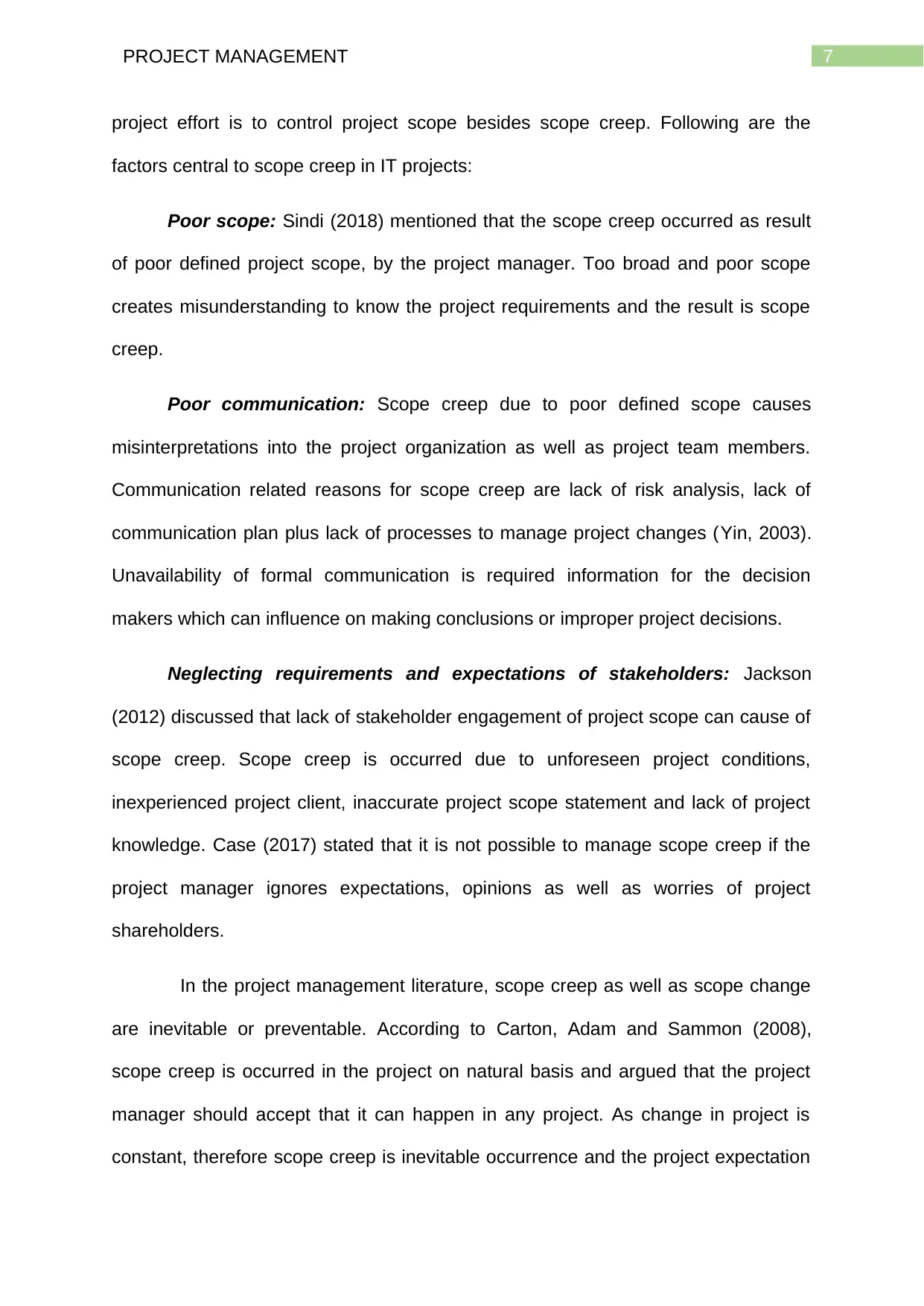
7PROJECT MANAGEMENT
project effort is to control project scope besides scope creep. Following are the
factors central to scope creep in IT projects:
Poor scope: Sindi (2018) mentioned that the scope creep occurred as result
of poor defined project scope, by the project manager. Too broad and poor scope
creates misunderstanding to know the project requirements and the result is scope
creep.
Poor communication: Scope creep due to poor defined scope causes
misinterpretations into the project organization as well as project team members.
Communication related reasons for scope creep are lack of risk analysis, lack of
communication plan plus lack of processes to manage project changes (Yin, 2003).
Unavailability of formal communication is required information for the decision
makers which can influence on making conclusions or improper project decisions.
Neglecting requirements and expectations of stakeholders: Jackson
(2012) discussed that lack of stakeholder engagement of project scope can cause of
scope creep. Scope creep is occurred due to unforeseen project conditions,
inexperienced project client, inaccurate project scope statement and lack of project
knowledge. Case (2017) stated that it is not possible to manage scope creep if the
project manager ignores expectations, opinions as well as worries of project
shareholders.
In the project management literature, scope creep as well as scope change
are inevitable or preventable. According to Carton, Adam and Sammon (2008),
scope creep is occurred in the project on natural basis and argued that the project
manager should accept that it can happen in any project. As change in project is
constant, therefore scope creep is inevitable occurrence and the project expectation
project effort is to control project scope besides scope creep. Following are the
factors central to scope creep in IT projects:
Poor scope: Sindi (2018) mentioned that the scope creep occurred as result
of poor defined project scope, by the project manager. Too broad and poor scope
creates misunderstanding to know the project requirements and the result is scope
creep.
Poor communication: Scope creep due to poor defined scope causes
misinterpretations into the project organization as well as project team members.
Communication related reasons for scope creep are lack of risk analysis, lack of
communication plan plus lack of processes to manage project changes (Yin, 2003).
Unavailability of formal communication is required information for the decision
makers which can influence on making conclusions or improper project decisions.
Neglecting requirements and expectations of stakeholders: Jackson
(2012) discussed that lack of stakeholder engagement of project scope can cause of
scope creep. Scope creep is occurred due to unforeseen project conditions,
inexperienced project client, inaccurate project scope statement and lack of project
knowledge. Case (2017) stated that it is not possible to manage scope creep if the
project manager ignores expectations, opinions as well as worries of project
shareholders.
In the project management literature, scope creep as well as scope change
are inevitable or preventable. According to Carton, Adam and Sammon (2008),
scope creep is occurred in the project on natural basis and argued that the project
manager should accept that it can happen in any project. As change in project is
constant, therefore scope creep is inevitable occurrence and the project expectation
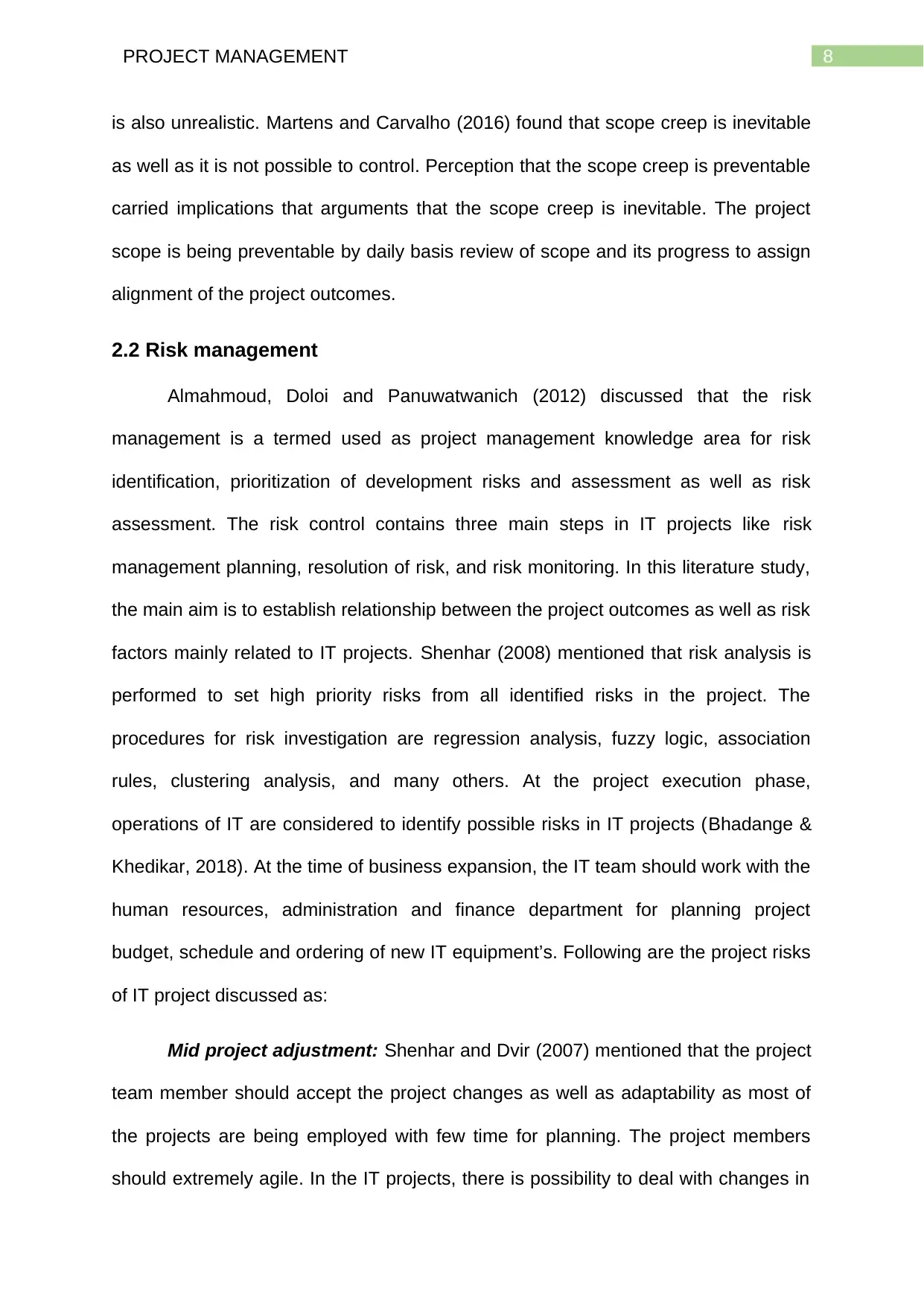
8PROJECT MANAGEMENT
is also unrealistic. Martens and Carvalho (2016) found that scope creep is inevitable
as well as it is not possible to control. Perception that the scope creep is preventable
carried implications that arguments that the scope creep is inevitable. The project
scope is being preventable by daily basis review of scope and its progress to assign
alignment of the project outcomes.
2.2 Risk management
Almahmoud, Doloi and Panuwatwanich (2012) discussed that the risk
management is a termed used as project management knowledge area for risk
identification, prioritization of development risks and assessment as well as risk
assessment. The risk control contains three main steps in IT projects like risk
management planning, resolution of risk, and risk monitoring. In this literature study,
the main aim is to establish relationship between the project outcomes as well as risk
factors mainly related to IT projects. Shenhar (2008) mentioned that risk analysis is
performed to set high priority risks from all identified risks in the project. The
procedures for risk investigation are regression analysis, fuzzy logic, association
rules, clustering analysis, and many others. At the project execution phase,
operations of IT are considered to identify possible risks in IT projects (Bhadange &
Khedikar, 2018). At the time of business expansion, the IT team should work with the
human resources, administration and finance department for planning project
budget, schedule and ordering of new IT equipment’s. Following are the project risks
of IT project discussed as:
Mid project adjustment: Shenhar and Dvir (2007) mentioned that the project
team member should accept the project changes as well as adaptability as most of
the projects are being employed with few time for planning. The project members
should extremely agile. In the IT projects, there is possibility to deal with changes in
is also unrealistic. Martens and Carvalho (2016) found that scope creep is inevitable
as well as it is not possible to control. Perception that the scope creep is preventable
carried implications that arguments that the scope creep is inevitable. The project
scope is being preventable by daily basis review of scope and its progress to assign
alignment of the project outcomes.
2.2 Risk management
Almahmoud, Doloi and Panuwatwanich (2012) discussed that the risk
management is a termed used as project management knowledge area for risk
identification, prioritization of development risks and assessment as well as risk
assessment. The risk control contains three main steps in IT projects like risk
management planning, resolution of risk, and risk monitoring. In this literature study,
the main aim is to establish relationship between the project outcomes as well as risk
factors mainly related to IT projects. Shenhar (2008) mentioned that risk analysis is
performed to set high priority risks from all identified risks in the project. The
procedures for risk investigation are regression analysis, fuzzy logic, association
rules, clustering analysis, and many others. At the project execution phase,
operations of IT are considered to identify possible risks in IT projects (Bhadange &
Khedikar, 2018). At the time of business expansion, the IT team should work with the
human resources, administration and finance department for planning project
budget, schedule and ordering of new IT equipment’s. Following are the project risks
of IT project discussed as:
Mid project adjustment: Shenhar and Dvir (2007) mentioned that the project
team member should accept the project changes as well as adaptability as most of
the projects are being employed with few time for planning. The project members
should extremely agile. In the IT projects, there is possibility to deal with changes in
⊘ This is a preview!⊘
Do you want full access?
Subscribe today to unlock all pages.

Trusted by 1+ million students worldwide
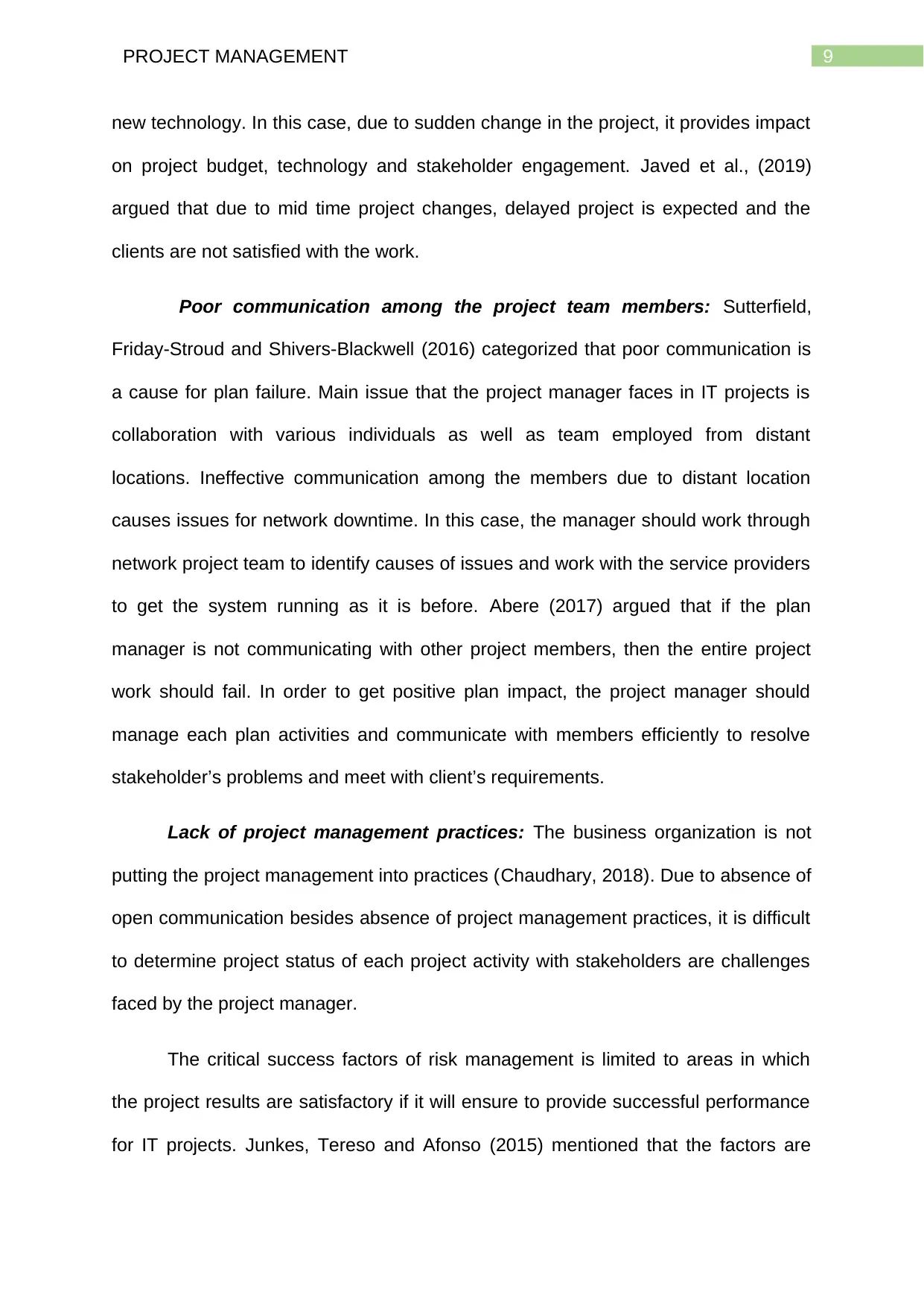
9PROJECT MANAGEMENT
new technology. In this case, due to sudden change in the project, it provides impact
on project budget, technology and stakeholder engagement. Javed et al., (2019)
argued that due to mid time project changes, delayed project is expected and the
clients are not satisfied with the work.
Poor communication among the project team members: Sutterfield,
Friday-Stroud and Shivers-Blackwell (2016) categorized that poor communication is
a cause for plan failure. Main issue that the project manager faces in IT projects is
collaboration with various individuals as well as team employed from distant
locations. Ineffective communication among the members due to distant location
causes issues for network downtime. In this case, the manager should work through
network project team to identify causes of issues and work with the service providers
to get the system running as it is before. Abere (2017) argued that if the plan
manager is not communicating with other project members, then the entire project
work should fail. In order to get positive plan impact, the project manager should
manage each plan activities and communicate with members efficiently to resolve
stakeholder’s problems and meet with client’s requirements.
Lack of project management practices: The business organization is not
putting the project management into practices (Chaudhary, 2018). Due to absence of
open communication besides absence of project management practices, it is difficult
to determine project status of each project activity with stakeholders are challenges
faced by the project manager.
The critical success factors of risk management is limited to areas in which
the project results are satisfactory if it will ensure to provide successful performance
for IT projects. Junkes, Tereso and Afonso (2015) mentioned that the factors are
new technology. In this case, due to sudden change in the project, it provides impact
on project budget, technology and stakeholder engagement. Javed et al., (2019)
argued that due to mid time project changes, delayed project is expected and the
clients are not satisfied with the work.
Poor communication among the project team members: Sutterfield,
Friday-Stroud and Shivers-Blackwell (2016) categorized that poor communication is
a cause for plan failure. Main issue that the project manager faces in IT projects is
collaboration with various individuals as well as team employed from distant
locations. Ineffective communication among the members due to distant location
causes issues for network downtime. In this case, the manager should work through
network project team to identify causes of issues and work with the service providers
to get the system running as it is before. Abere (2017) argued that if the plan
manager is not communicating with other project members, then the entire project
work should fail. In order to get positive plan impact, the project manager should
manage each plan activities and communicate with members efficiently to resolve
stakeholder’s problems and meet with client’s requirements.
Lack of project management practices: The business organization is not
putting the project management into practices (Chaudhary, 2018). Due to absence of
open communication besides absence of project management practices, it is difficult
to determine project status of each project activity with stakeholders are challenges
faced by the project manager.
The critical success factors of risk management is limited to areas in which
the project results are satisfactory if it will ensure to provide successful performance
for IT projects. Junkes, Tereso and Afonso (2015) mentioned that the factors are
Paraphrase This Document
Need a fresh take? Get an instant paraphrase of this document with our AI Paraphraser
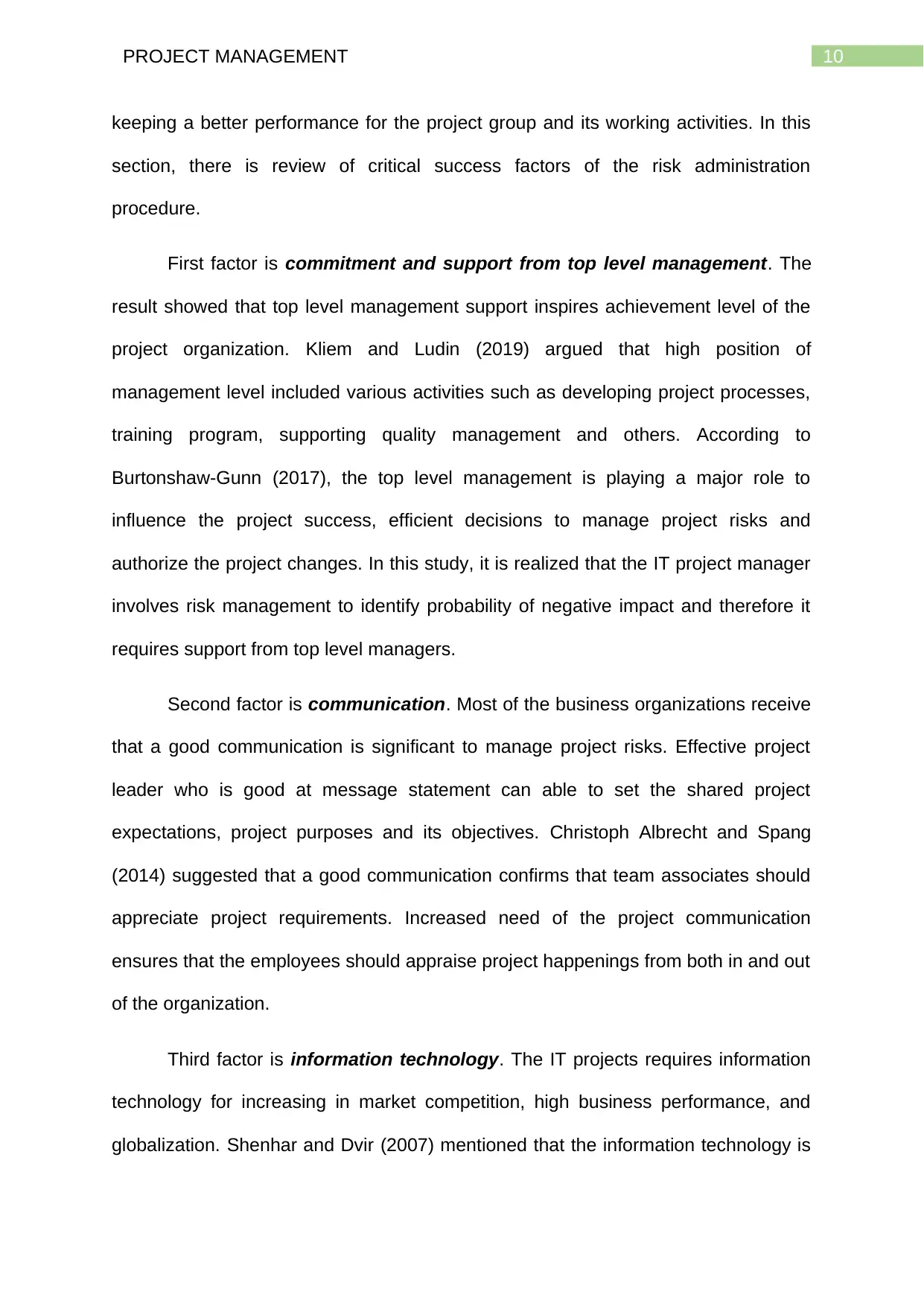
10PROJECT MANAGEMENT
keeping a better performance for the project group and its working activities. In this
section, there is review of critical success factors of the risk administration
procedure.
First factor is commitment and support from top level management. The
result showed that top level management support inspires achievement level of the
project organization. Kliem and Ludin (2019) argued that high position of
management level included various activities such as developing project processes,
training program, supporting quality management and others. According to
Burtonshaw-Gunn (2017), the top level management is playing a major role to
influence the project success, efficient decisions to manage project risks and
authorize the project changes. In this study, it is realized that the IT project manager
involves risk management to identify probability of negative impact and therefore it
requires support from top level managers.
Second factor is communication. Most of the business organizations receive
that a good communication is significant to manage project risks. Effective project
leader who is good at message statement can able to set the shared project
expectations, project purposes and its objectives. Christoph Albrecht and Spang
(2014) suggested that a good communication confirms that team associates should
appreciate project requirements. Increased need of the project communication
ensures that the employees should appraise project happenings from both in and out
of the organization.
Third factor is information technology. The IT projects requires information
technology for increasing in market competition, high business performance, and
globalization. Shenhar and Dvir (2007) mentioned that the information technology is
keeping a better performance for the project group and its working activities. In this
section, there is review of critical success factors of the risk administration
procedure.
First factor is commitment and support from top level management. The
result showed that top level management support inspires achievement level of the
project organization. Kliem and Ludin (2019) argued that high position of
management level included various activities such as developing project processes,
training program, supporting quality management and others. According to
Burtonshaw-Gunn (2017), the top level management is playing a major role to
influence the project success, efficient decisions to manage project risks and
authorize the project changes. In this study, it is realized that the IT project manager
involves risk management to identify probability of negative impact and therefore it
requires support from top level managers.
Second factor is communication. Most of the business organizations receive
that a good communication is significant to manage project risks. Effective project
leader who is good at message statement can able to set the shared project
expectations, project purposes and its objectives. Christoph Albrecht and Spang
(2014) suggested that a good communication confirms that team associates should
appreciate project requirements. Increased need of the project communication
ensures that the employees should appraise project happenings from both in and out
of the organization.
Third factor is information technology. The IT projects requires information
technology for increasing in market competition, high business performance, and
globalization. Shenhar and Dvir (2007) mentioned that the information technology is

11PROJECT MANAGEMENT
related to aspects of business like access to network infrastructure, technical
knowledge, and allocation of resources, human assets and communication support.
By using IT equipment, there is redesigning of business process and improving the
profitability of business.
2.3 Cost management
This section is discussed on controlling the project cost. In the It project, the
project cost is the cost needed to procure all required products, services as well as
resources for distributing the project work. Lock (2017) discussed that decision of
project success is taken from how well the project work is being handled into the
project plan. Most of the time it is possible that the development work is not finished
on scheduled interval and cost. Therefore, it is required to perform accurate
estimation of project cost. Harrison and Lock (2017) mentioned that importance of
cost control into success of project management is something that each project
manager is familiar. As time as well as resource management is difficult to achieve
development goal, therefore cost performance determines a positive outcome of the
project. In order to establish a control over plan budget, the project manager
exercises a strict supervision of project cost. Papke-Shields and Boyer-Wright (2017)
argued that if the venture cost is not managed properly, then it is hard to handle
complex IT projects. Control over project budget includes identification of sources of
IT project cost from starting of the project planning.
In order to control over project cost, earned value management is used as
effective process to track project cost as well as examine project expenditures
related to project work. Fleming and Koppelman (2016) mentioned that when the
total project cost of IT project at provided time is over cost baseline, then cost
measurements are required. Earned value management (EVM) is looked at cost,
related to aspects of business like access to network infrastructure, technical
knowledge, and allocation of resources, human assets and communication support.
By using IT equipment, there is redesigning of business process and improving the
profitability of business.
2.3 Cost management
This section is discussed on controlling the project cost. In the It project, the
project cost is the cost needed to procure all required products, services as well as
resources for distributing the project work. Lock (2017) discussed that decision of
project success is taken from how well the project work is being handled into the
project plan. Most of the time it is possible that the development work is not finished
on scheduled interval and cost. Therefore, it is required to perform accurate
estimation of project cost. Harrison and Lock (2017) mentioned that importance of
cost control into success of project management is something that each project
manager is familiar. As time as well as resource management is difficult to achieve
development goal, therefore cost performance determines a positive outcome of the
project. In order to establish a control over plan budget, the project manager
exercises a strict supervision of project cost. Papke-Shields and Boyer-Wright (2017)
argued that if the venture cost is not managed properly, then it is hard to handle
complex IT projects. Control over project budget includes identification of sources of
IT project cost from starting of the project planning.
In order to control over project cost, earned value management is used as
effective process to track project cost as well as examine project expenditures
related to project work. Fleming and Koppelman (2016) mentioned that when the
total project cost of IT project at provided time is over cost baseline, then cost
measurements are required. Earned value management (EVM) is looked at cost,
⊘ This is a preview!⊘
Do you want full access?
Subscribe today to unlock all pages.

Trusted by 1+ million students worldwide
1 out of 48
Related Documents
Your All-in-One AI-Powered Toolkit for Academic Success.
+13062052269
info@desklib.com
Available 24*7 on WhatsApp / Email
![[object Object]](/_next/static/media/star-bottom.7253800d.svg)
Unlock your academic potential
Copyright © 2020–2025 A2Z Services. All Rights Reserved. Developed and managed by ZUCOL.



